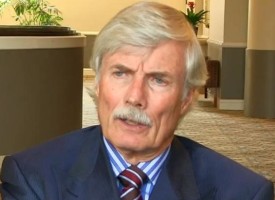If you are worried about the action in silver and gold, just read this…
Taper Tantrum Takes a Bite Out of Gold
March 4 (King World News) – Paul Wong, Market Strategist at Sprott Asset Management: Gold bullion is down 8.66% YTD through February 28, 2020, but is up 9.36% YOY. Gold mining equities have fallen 16.78% YTD but have increased 11.37% YOY. Silver and platinum are the precious metals standouts for the recent period, up 1.01% and 11.28% YTD, and 60.02% and 37.71% YOY, respectively. This compares to 1.72% YTD and 31.29% YOY returns for the S&P 500 TR Index.
Gold Blues as Silver Woos
February was a tough month for gold, which marked its worst monthly performance since November 2016. Spot gold fell $114/oz, or 6.15%, to close the month at $1,734/oz. Half of this decline came in the two final days of February, as bond selling spiked into near panic mode and triggered a multi-asset sell-off into month-end. Figure 1 shows how gold has been inversely correlated to bond yields.
February’s pullback occurred on the back of various developments. Rising energy prices and the markets’ view on U.S. government spending bolstered the reflation trade with a rally in broader equity markets. The U.S. dollar strengthened as markets priced in a swift economic recovery and as U.S. Treasury yields advanced to the highest level in a year, with the 30-year bond rising above 2% and the rapid move in the 10-year to over 1.5%, which we will discuss in more detail. Meanwhile, gold ETFs saw holdings decline towards the end of February. Silver prices held up much better as markets sought out physical ownership and recognized silver’s undervalued economic merits. Gold stocks were drawn down in a volatile fashion with the gold price move. Precious metal equities followed physical metals’ performance, with silver related stocks outperforming gold stocks…
To learn which company billionaire Eric Sprott just bought a
$10 million stake in click here or on the image below

February Ends with a Full Blown Tantrum
For the past several years, Federal Reserve (Fed) policies have driven yields continually lower, and as a result, most asset classes now have embedded duration effects. For gold, this duration effect is in the real yield. The sudden backup in real interest rates was shockingly quick ― nearly 40 basis points in six trading sessions. The rise in real yields was driven almost exclusively by the rise in nominal rates on the back of term premiums (expectations) backing up. There is just no escaping the pervasive effects and consequences of central bank policies in any asset class.
Since August 2020, the U.S. 10-year Treasury nominal yield has been rising, which the Fed has viewed as benign and as a sign of better growth, as rising breakeven yields led it. Just in case, the Fed would reiterate that it was not even thinking about raising rates, and with its new AIT (average inflation targeting) policy, that it would be a long time before the Fed would raise interest rates even in the face of rising inflation. But once 10-year U.S. Treasury yields rose above 1.20%, the bond market began to sell-off and closed out February with a full-blown “taper tantrum.”
The Reflation Narrative Continues to Grow
Since early January, the reflation narrative has continued to build, igniting a growing bear steepener trade (investors demanding higher yields in longer-dated bonds to offset the risk of growth and inflation). By the last week of February, tail hedgers had switched from bear steepeners to bear flatteners (yields rising in the curve’s middle or belly). Also, new short positions were established in three-year Eurodollar futures (greens). These two trades signaled that the Fed would need to tighten (raise rates) way ahead of its stated schedule. Furthermore, this tightening would be by way of tapering QE (quantitative easing), which would impact the belly of the U.S. Treasury curve the most (the bear flattener trade).
When CTAs flipped to bearish (mechanical selling), this compounded the selling pressure. The final catalyst was the failure of last Thursday’s (February 25) 7-year U.S. Treasury note auction. Investors showed tepid demand for the $62 billion worth of notes, with the bid-to-cover ratio at just 2.04, the lowest in the auction’s history. In response, the U.S. 10-year Treasury yield exploded higher to reach 1.6085% but reversed sharply to close at 1.40% for the month, likely a climactic selling spike.
Not lost on the market was that three-year Treasury yields rose the most last Thursday (2/25/2021) , climbing nine basis points. Fed policy should have kept this part of the yield curve nailed to the floor, and the Fed’s failure to do so brought into question its creditability. Not helping was the Fed’s silence into the month-end taper tantrum selling panic. If the bond market remains unstable in the near term, we would expect some Fed jawboning. If that were not enough, then the next step would be WAM (weighted average maturity) extension and possibly a change in QE composition…
ALERT:
Billionaire and mining legend Ross Beaty, Chairman of Pan American Silver, just spoke about what he expects to see in the gold and silver markets and also shared one of his top stock picks in the mining sector CLICK HERE OR ON THE IMAGE BELOW TO HEAR BEATY’S INTERVIEW.

Currently, the Fed is buying $80 billion in Treasuries and $40 billion in mortgage-backed securities each month. The Fed can shift towards more Treasury purchases. The Fed can also bring up the YCC (yield curve control) debate again and wave that at the market. But the bigger question is: Have we reached the point where U.S. 10-year Treasury yields at only 1.50% and 10-year real yields at -0.75% are a threat to the bond market’s stability? Or is instability due to rates moving too fast, too quickly?
Looking at the flipside extreme, what would happen if the Fed decides (or were forced) to increase WAM, QE and bring in some form of YCC? This would likely mean unlimited liquidity for equities, low yields across the curve to finance all fiscal programs and corporate bond spreads would narrow even more. It would also be the last nail in the coffin for price discovery. Markets would soar until the weight of unsustainability causes a systematic market crash that wipes out the majority of wealth — this is one of the extreme right-tail risk events we highlighted in our November commentary, Gold Tests $1,800 Support.
Bullish View on Gold Remains Intact
Although we are disappointed by gold’s recent price weakness, we recognize that market flows, positioning and momentum can dominate price action in the near term in today’s market environment. The last week of February was an uncomfortable replay of the 2013 Taper Tantrum in a condensed form. Two scenarios are likely going forward. One is that the Fed will taper, and yields will rise. The second is that the Fed stays the course.
The Fed taper scenario is a total non-starter. Here’s why. If the Fed were to truly taper, real yields would rise dramatically. Figure 2 highlights the relationship between the S&P 500 forward P/E multiples and the 10-year real yield over the past five years (the R-squared is 73%). Not only would P/E multiples collapse, but earnings expectations would see headwinds as higher yields bite into the earnings outlook. Rising real yields would strengthen the U.S. dollar (USD), further tightening financial conditions. In this scenario, the stock market would likely enter a bear market given current dot-com-level valuations.
Without the current high QE level, further fiscal expansion programs would come to a halt, and GDP (gross domestic product) growth expectations would hit the wall. Under this taper outlook (basically, the Fed no longer providing full support), one would reduce exposure in equities, bonds, commodities, gold and everything else. The corollary argument is that growth is now so strong and established (despite being in the early stages of the post-COVID recovery) and is now impervious to any taper action. This would go against the entire notion and purpose of AIT (average inflation targeting). Despite the recent tantrum, the Fed fully controls the world’s reserve currency’s printing press (USD). The Fed is the boot, and bond vigilantes remain the ant (remember The Avengers from 2012?). All tantrums will come to an end, including this one.
Rising Volatility Benefits Gold
By staying the course, the market’s significant risk would be inflation, which is what the Fed is trying to engineer, and why the bond market is in a tantrum. It is not surprising that the bond market reacted in this manner; it is now the primary source of market risk and volatility. Staying the course will mean continuing massive fiscal stimulus leading to ever-expanding M2 money supply and continuing deep negative real yields and a weak USD. The yield curve has already steepened and will likely climb higher in the face of such fiscal spending. Figure 3 highlights the relationship between the 2s10s Treasury yield curve, the MOVE Index (implied bond volatility) and the VIX Index. Historically, the yield curve is the best predictor of the MOVE Index direction. For several years, the MOVE Index had been relatively constrained by Fed policy, which has now come to an end. An untethered MOVE Index will increase cross-asset class volatility (MOVE and VIX generally move together).
Rising volatility in all asset classes will place a greater demand for effective hedges and diversification. Our 2021 Top 10 Watch List commentary highlighted all these points (M2 growth, real yields, USD and market volatility) and their relationship to gold. The long-term trends remain in place for a bullish gold view.
Fed Guidance will Impact Short-Term Price Action of Gold
Since the summer peak, we were looking for gold to maintain the support level at $1,800 or “stickiness” around $1,800. That level would have been a high-level support price similar to what silver is experiencing. The $1,800 level gave way in the final two days of February and has fallen to the first Fibonacci retracement, or support, at $1,725 and is still above the trendline from the 2018 lows (Figure 4). The gold price is also sitting in a cluster of support, marked by the blue dashed lines. The upper blue dash line marked the resistance level before the August melt-up to the peak.
Despite the gyrations, gold remains in a bullish trend but is now testing critical medium-term support levels. The relative strength index (RSI) is at extreme oversold levels consistent with prior tradeable lows (bottom panel, red circles). The movement in yields and Fed guidance will likely determine the short-term price action of gold bullion. There are plenty of technical indicators showing yields have reached a short-term climactic blow-off action. Longer-term, the probability of an early Fed taper seems unlikely, but gold has discounted some of this already.
More Trouble with Bonds, Asset Allocation View
For decades, bond yields have been in one of the most prolonged secular declines in history. In recent decades, when a financial stress event or calamity occurred, central banks quickly cut interest rates. In terms of the Fed’s reaction function’s prime beneficiary, it has been consistently bonds. Post the GFC (global financial crisis), bonds had morphed to become increasingly negatively correlated to equities and had become the best hedge in a multi-asset portfolio. But with ZIRP (zero interest rate policy), the ability of bonds to act as a hedge is likely gone unless the Fed is willing to go negative on yields. Bonds will still work as a diversifier, but the difference between a hedge and a diversifier is cavernous in any value-at-risk (VaR) based scenario. Figure 5 highlights how extraordinarily well this hedge function worked before ZIRP. Ideally, the price correlation between assets should be negatively correlated in a pronounced manner.
Using the SPDR S&P 500 ETF (SPY) as the equity and the iShares 20+ Year Treasury ETF (TLT) as the bond, from January 2017 up until the Fed going to a ZIRP in March 2020, there was a very marked negative correlation pattern between SPY and TLT (blue line). Perhaps almost as necessary, the volatility of equities (VIX) and bonds (MOVE) should be highly positively correlated so that volatility events are aligned. The upper and lower green dashed boxes mark this extraordinary period of hedge protection. Since the start of ZIRP, the correlations of both SPY-TLT and VIX-MOVE have broken, and it is clear the hedge function is gone. As a result, we see more asset classes, such as gold, being added to multi-asset portfolios to increase overall portfolio diversification without an effective hedge.
Bitcoin: Take A Walk on the Wild Side
Before the end-of-month bond market tantrum, the most extraordinary story in February was Bitcoin. Since autumn, Bitcoin has increased fivefold based on… we are not entirely sure exactly what, exactly. Typically when a security rises fivefold to top $1 trillion in market valuation, there are clear explanations. For Bitcoin, there are several, including increased adoption and institutional acceptance as a store of value, a new currency, or as a new asset class. However, Bitcoin has no prominent value foundation other than market participants’ willingness to buy it and lots of it.
The one unassailable observation, though, is that Bitcoin is volatile, very volatile. Figure 6 shows Bitcoin’s rolling 30-day realized volatility compared to gold and a G7 currency volatility index. Often Bitcoin is compared to gold from the perspective that both are in limited supply, and both can be viewed as an alternative currency. From a volatility perspective, they are nothing alike. The five-year average of the 30-day realized volatility for Bitcoin (58.5%) is 4.4 times higher than gold bullion (13.2%) and 7.2 times higher than the G7 currency volatility index (8.1%). Though the five-year average may seem tempered, one look at the volatility chart in Figure 6, and the phrase “random walk” comes to mind…
New interview from legend Doug Casey discussing gold, silver and
global chaos! To listen click here or on the image below.

While the claim of a limited supply of each individual cryptocurrency coin is accurate, there are no limits to the number of cryptocurrencies available. Over 8,600 known cryptocurrencies are now in circulation at last count (and growing), with a market value hitting over $1.7 trillion at the highs. For reference, the Fed states there is $2.05 trillion in Federal Reserve Notes in circulation. The limited supply or scarcity factor holds for single coins but does not hold for cryptocurrencies in aggregate. The alternative currency (or store of value) narrative is also problematic for Bitcoin, given its extreme volatility. Bitcoin was down by more than 20% in reaction to comments by Elon Musk and Janet Yellen. Generally, most prudent investors don’t like to see their other stores of value drop more than 20% in less than two days due to two people stating apparent facts, even if it may be up a phenomenal 427% year-over-year. The long-term history of assets going hyperbolic does not always end well.
Are we negative on cryptocurrencies? No, but we would like to be clear and say they are not the same as gold. Unlike a tangible asset, cryptos exist only in the digital realm and, as such, can disappear if governments, for whatever reason, choose to do so. But the speed of adoption and market value of cryptocurrencies cannot be denied. Cryptocurrencies are here to stay and will continue to evolve. The more that cryptocurrencies are adopted, the harder it will be for governments to legislate them out of existence. The data history for Bitcoin is limited relative to most other asset classes. However, besides extreme volatility, Bitcoin has so far demonstrated a relatively low correlation to most asset classes, making it viable as a diversifier in a multi-asset portfolio, depending on the allowed volatility. For most funds, that would mean a relatively small allocation. Our early analysis would indicate that Bitcoin could be a helpful addition to a precious metals allocation but not as a substitute ― take one last look at that volatility.
Metals Miners: An Attractive Buying Opportunity
On a final note, we continue to believe that the amount of monetary and fiscal stimulus central banks and governments are providing, the resulting debasement of currencies and the inflationary outcome will support gold, silver and precious metals equities for some time. Markets, however, are focused more on the potential for economic growth and ignoring the value generated by the profitable precious metals mining sectors. From our perspective, this certainly presents an attractive buying opportunity and entry point for new capital. Despite the current metals price correction, precious metals equity valuations are fundamentally very attractive because of the profit margin and favorable financial conditions of the sector.
To listen to a powerful and timely interview with E.B. Tucker about the fierce trading action in the gold and silver markets CLICK HERE OR ON THE IMAGE BELOW.
Alasdair Macleod discusses why the gold and silver markets are very close to a major bottom CLICK HERE OR ON THE IMAGE BELOW TO LISTEN.
© 2021 by King World News®. All Rights Reserved. This material may not be published, broadcast, rewritten, or redistributed. However, linking directly to the articles is permitted and encouraged.















